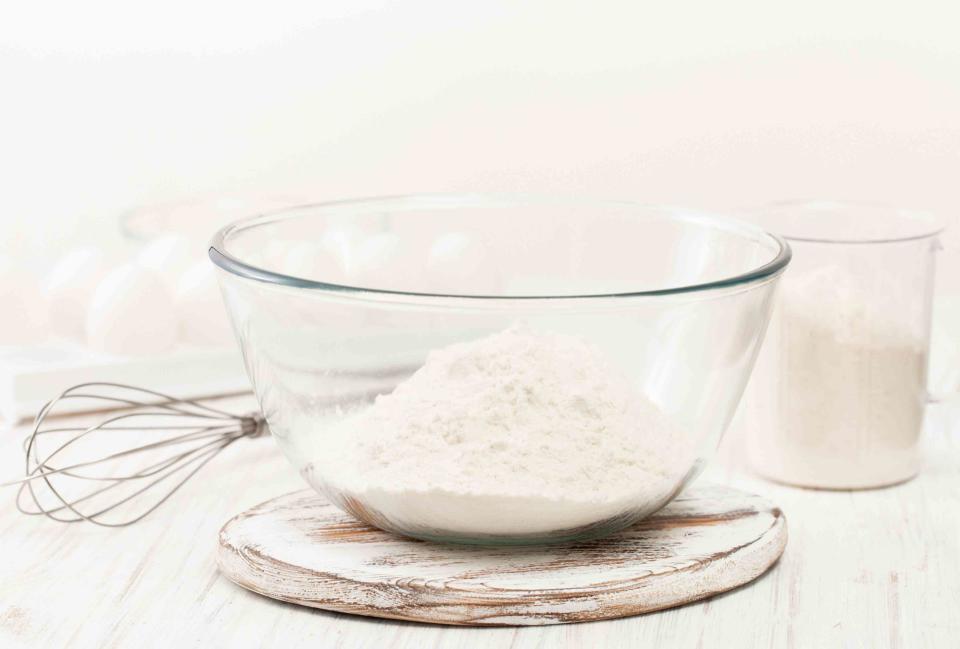Cake Flour and All-Purpose Flour Aren't the Same—Here's When to Use Each
Also, an easy substitute if you don't have cake flour.

Kelly J Hall / Getty Images
You checked the list, went to the store, and thought you had all the ingredients to make the cake, only to get home and realize you need cake flour. We've all been there. You do, however, have all-purpose flour. Before you use it in place of cake flour or schlep back to the store, here's what you need to know about cake flour and all-purpose flour, as well as how to swap one for the other.
Meet Our Expert
Melanie Wanders, research and development specialist at King Arthur Baking Company
Jason Schreiber, food stylist, recipe developer, and author of Fruit Cake: Recipes for the Curious Baker.
Trung Vu, chef-instructor of pastry and baking arts at the Institute of Culinary Education's New York City campus.
Related: Our Most Popular Cake Recipes of All Time
What Is Cake Flour?
Every type of flour has a protein percentage, which reflects how much gluten-forming protein it contains. As protein level correlates with gluten-forming potential, Melanie Wanders, research and development specialist at King Arthur Baking Company, says it's helpful to think of the protein percentage this way: the higher the protein content, the "stronger" the flour.
Cake flour tends to have a low protein count, generally about 6 to 8 percent. It's also very finely milled. In the U.S., most (but not all) cake flour is bleached, a chemical process that affects the way the starch molecules absorb moisture and bind with fats.
This results in cakes that have a softer texture, a more even crumb, and a higher rise than those made with unbleached flour, says Jason Schreiber, recipe developer, food, stylist, and author of Fruit Cake: Recipes for the Curious Baker.
You'll typically see recipes for cakes, muffins, and other crumbly baked goods call for cake flour.
What Is All-Purpose Flour?
"All-purpose flour is just that, a middle-of-the-road solution that works in most instances," Schreiber says.
Different brands of all-purpose flour have different amounts of protein, although generally, all-purpose flour contains about 9 to 11 percent protein. You'll find all-purpose flour both bleached and un-bleached.
All-purpose flour, or the even higher-gluten bread flour at 13 to 15 percent protein, will do better in bread or pizza where you want more heft or a denser texture with a chew to it, says Trung Vu, a chef-instructor of pastry and baking arts at the Institute of Culinary Education's New York City campus.
Cake Flour vs. All-Purpose Flour
The biggest difference between cake flour and all-purpose flour is the protein content.
"When making baked goods like bread, strong flour with high protein makes sense. The robust glutinous web that develops when the flour is combined with liquid results in bread with a chewy, bouncy texture," says Wanders.
But when making a cake, it's the opposite: We want something with a soft, fine, and tender crumb. In order to get it, we want to discourage gluten development, and one way to do that is to choose a flour with a lower protein content.
Related: 5 Most Common Types of Flour—and How to Sub One for Another
When to Use Cake Flour
Much as its name suggests, you'll want to use cake flour in cakes, especially cakes that are airy, such as angel food cake. And although it's called cake flour, it's not just for cake. Cake flour can also be used in cookies, biscuits, muffins, and pancakes.
"Cake flour is used in recipes that require a lower protein count to achieve a softer, tighter crumb, usually, as the name would imply, in cakes, muffins, and the like," Schreiber says.
Tips
Bleached vs. Unbleached Cake Flour
Bleached cake flour absorbs more liquid and bonds more readily with fat than unbleached cake flour, so it's important to use the type of flour called for in a recipe to get the expected results. "Using the wrong kind can result in dramatically different textured batters and final products," says Schreiber.
What to Use If You Don't Have Cake Flour
While the best practice is to use the flour that is called for in a recipe, it might not always be possible. All-purpose flour can be used in place of cake flour in most recipes that specify cake flour, but there will be a difference in the final product. "Because of the higher protein and gluten development, cakes made using all-purpose flour will be slightly heavier and less delicate," says Vu.
How to Make an Easy Cake Flour Substitute
You can also try making this easy substitute, using it by equal weight or volume. For every 1 cup (120g) unbleached cake flour called for in a recipe:
Whisk together 3/4 cup + 2 tablespoons (105g) all-purpose flour and 2 tablespoons (14g) cornstarch.
"The cornstarch adds tenderness and lowers the overall protein content of the mixture to mimic that of cake flour," Wanders says.
Related: Baking Soda vs. Baking Powder: The Differences Between These Popular Leavening Agents
Can You Use Cake Flour for All-Purpose?
On the flip side, cake flour is almost never used as a substitute for all-purpose or bread flour, says Vu. This is because it would never develop enough gluten, which provides the structure for most breads.
Read the original article on Martha Stewart.

